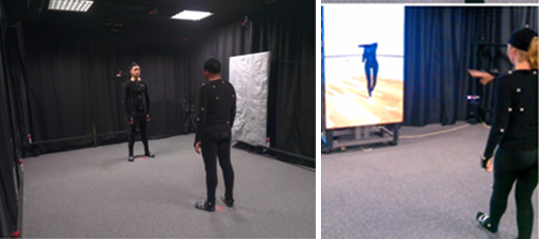CPU
Modeling Intra- and Inter-individual Variability
We conduct research in computer science and psychology on individual characteristics, particularly those related to emotions and social interaction. Our research takes into account different approaches to personality that go beyond those usually used in affective computing. These include the Big Five, sensory preference (RFT), Regulatory Focus and Followership models. We link these models to concepts such as stress, anxiety and empathy.
We seek to highlight and explain intra- and inter-individual differences in the context of human/human or human/virtual interactions. Part of our work focuses on understanding the action and perception of expressive movement during a dyadic interaction.Our research among healthy and disabled individuals highlights inter- and intra-individual variabilities in bodily and postural behaviors as a function of emotions experienced during human/human or human/virtual social interactions (ANR project NGREDIBLE; Giraud et al., 2016 ; Chevalier et al., 2016).
Application views
One applicative aim is the creation of a virtual coach who, by means of these expressive movements, enables a more dynamic and credible interaction (Giraud et al., 2016). Applied to the professional context, we are also interested in hierarchical dyadic interaction. Thus we seek to identify the intra-individual variability of leadership behaviors as a function of perceived followership behavior. The aim of this research, carried out with professional firefighters (but also with non-professionals), is (1) to identify the behavioral cues (i.e., non-verbal behaviors) of subordinates that enable them to be categorized by leaders, (2) to collect a repertoire of non-verbal behaviors that can be implemented in a virtual training environment, and (3) to identify the implicit categorization processes implemented by leaders. The aim is to design a virtual subordinate that can be used to train medical leaders (ANR VICTEAMS ; Demary et al., 2017).
In addition, socio-emotional characteristics such as alexithymia, anxiety (trait and state) and stress management are studied in the context of interactions with different devices during a social stress situation (job interview simulation in the ANR COMPARSE project). Adolescents’ adaptive strategies when faced with virtual characters (i.e., approach and avoidance behavior) could also be tested via the use of automatic video detection tools (Gomez et al., 2013).
Finally, studying inter and intra variability in real and virtual interactions requires the adaptation and development of specific measurement tools. A scale to measure individuals’ regulatory focus chronic has been developed (Faur et al., 2016). As part of studies conducted on subordinates in a professional context, a scale aimed at identifying belief styles on followership has been developed and used (Demary, 2018).


